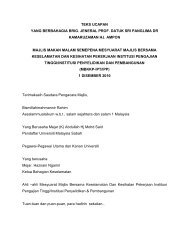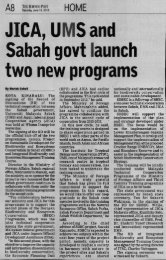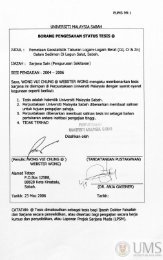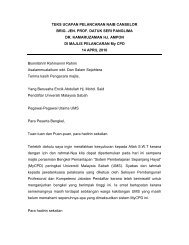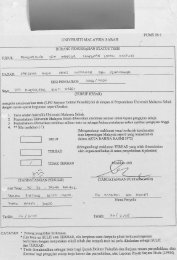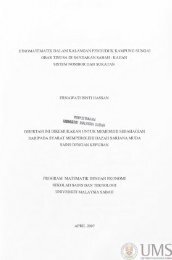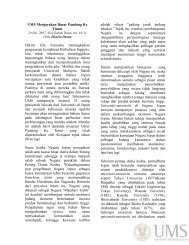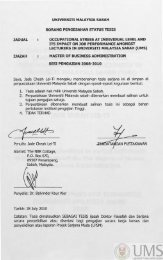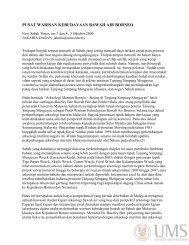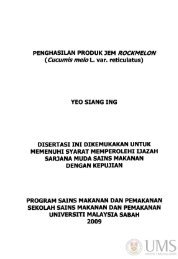references
references
references
Create successful ePaper yourself
Turn your PDF publications into a flip-book with our unique Google optimized e-Paper software.
JUOUL:<br />
IJAZAH:<br />
UNIVERSITI MALAYSIA SABAH<br />
BORANG PENGESAHAN STATUS TESIS@<br />
PENYELIOIKAN OALAM PENENTUAN BAGI JENAMA<br />
KORPORAT OALAM INOUSTRI FESYEN 01 BAN OAR KOTA<br />
KINABALU, SABAH.<br />
SARJANA PENGURUSAN PERNIAGAAN<br />
SESI PENGAJIAN: 2005 - 2007<br />
Saya, HO SU SAN mengaku membenarkan tesis Sarjana ini disimpan di<br />
Perpustakaan Universiti Malaysia Sabah dengan syarat-syarat kegunaan seperti<br />
berikut:<br />
1. Tesis adalah hakmilik Universiti Malaysia Sabah.<br />
2. Perpustakaan Universiti Malaysia Sabah dibenarkan membuat salinan untuk tujuan<br />
pengajian saya.<br />
3. Perpustakaan dibenarkan membuat salinan tesis ini sebagai bahan pertukaran<br />
antara institusi pengajian tinggi.<br />
4. TIDAK TERHAD.<br />
(P:erT'd'Tis: HO SU SAN)<br />
Alamat:<br />
P. O. BOX 980,<br />
90710 Sandakan,<br />
Sabah, Malaysia.<br />
Tarikh: 2007<br />
Disahkan oleh<br />
(TANDATANGAN PERPUSTAKAWAN)<br />
(Penyelia: Pn. Dayangku Aslinah Abd. Rahim)<br />
Tarikh:<br />
CATATAN: @ Tesis dimaksudkan sebagai tesis Ijazah Doktor Falsafah dan Sarjana<br />
secara penyelidikan atau disertassi bagi pengajian secara kerja kursus dan penyelidikan<br />
atau laporan Projek Sarjana Muda (LPSM).
A STUDY ON THE DETERMINANTS OF<br />
CORPORATE BRAND IMAGE IN THE<br />
FASHION RETAIL INDUSTRY<br />
HO SU SAN<br />
A dissertation submitted in partial fulfillment of the<br />
requirements for the degree of Masters of Business<br />
Administration<br />
SCHOOL OF BUSINESS AND ECONOMICS<br />
UNIVERSITY MALAYSIA SABAH<br />
2007
DECLARATION<br />
The material in this dissertation are original except for quotations, excerpts, summaries and<br />
<strong>references</strong>, which have been duly acknowledge.<br />
Ho Su San<br />
PS05-006(K)-025<br />
6 July 2007
ACKNOWLEGDEMENT<br />
The completion of this study was made possible by the assistance, cooperation, ideas and<br />
input of various individuals. First of all, I would like to thank God for granting me the<br />
spiritual guidance, supports, perseverance and will to complete this study. I am very<br />
grateful to my husband and my family member for their constant support, understanding<br />
and patient.<br />
Secondly, my gratitude and appreciation also goes to my supervisor, Ms. Grace<br />
Phang and my co-supervisor, Dr. Fumitaka guided me through this study. I also would like<br />
to express my heartfelt gratitude to all my MBA lecturers and classmates for their support<br />
and inputs which eventually led to the betterment of my research.<br />
Special thanks for all those who have assisted me in SPSS analysis and also to<br />
those who have participated in this research. Your valued contribution is greatly<br />
appreciated.<br />
ii
ABSTRACT<br />
Corporate brands are an increasingly important element of organizational and marketing<br />
strategy. Among the changes that businesses make as they move towards globalization is<br />
a shift in marketing emphasis from product brands to corporate branding. In an era when<br />
companies can no longer base their strategy on a predictable market or a stable<br />
preferential product range, the ground rules for competition change. Differentiation requires<br />
positioning, not of products, but the whole corporation. Accordingly, the values and<br />
emotions symbolized by the organization become key elements of differentiation strategies,<br />
and the corporation itself moves center stage. The proposed research takes a look at the<br />
determinants of the retail corporate branding for the fashion industry. The purpose of this<br />
research is to identify and study the different constructs of corporate brand management of<br />
retailers in the Kota Kinabalu. In summary, this study was analyzed by using various<br />
statistical analyses, which investigate the determinants of the corporate brand image for<br />
both the local and foreign fashion retails from the customers' perspective. Results showed<br />
that physical facilities and store atmosphere proves to have the most significant influence<br />
on corporate brand image for both the local and foreign fashion retails. Management<br />
implications and suggestions for future research are discussed.<br />
iii
ABSTRAK<br />
PENYELID/KAN DALAM PENENTUAN BAGI JENAMA KORPORA T DALAM<br />
/NDUSTR/ FESYEN<br />
Jenama korporat semakin memainkan peranan yang penting da/am satu organisasi<br />
dan strategi pemasaran Antara perubahan da/am bidang pemiagaan ke arah<br />
g/obalisasi ia/ah pertukaran ha/a tuju dari jenama barangan kepada jenama<br />
korporat. Da/am era di mana sesebuah syarikat tidak dapat bergantung kepada<br />
strateginya da/am pasaran rama/an atau stabiliti dalam memberi keutamaan da/am<br />
sesuafu produk yang merupakan asas bagi suatu saingan pemiagaan. Perbezaan<br />
dalam sesebuah syarikat per/u memberi keutamaan da/am se/uruh korporat dan<br />
bukan hanya setakat barangan sahaja. Nilai dan emosi yang ditunjukkan o/eh suatu<br />
organisasi akan menjadi satu ciri ufama da/am membezakan strateg; bag; korporat<br />
tersebut untuk menarik perhatian para konsumer. Penye/idikan in; membincangkan<br />
penentu bagi jenama korporat dalam industri fesyen. Tujuan penye/idikan ini ia/ah<br />
untuk menentukan dan membincangkan perbezaan da/am pengurusan jenama<br />
korporat di sekitar Kota Kinaba/u. Kesimpulannya, thesis ini menggunakan pe/bagai<br />
ana/isis statistik bagi mendapatkan penentu untuk jenama korporat tempatan dan<br />
antarabangsa dari pandangan konsumer. Hasil kajian menunjukkan kemudahan<br />
dan keadaan butik je/as menunjukkan pengaruh yang penting da/am jenama<br />
korporat bag; pem;agaan fesyen tempatan dan antarabangsa. Imp/ikasi<br />
pengurusan dan cadangan bagi kajian seterusnya juga akan dibincangkan.<br />
iv
TITLE PAGE<br />
DECLARATION<br />
ACKNOWLEDGEMENTS<br />
ABSTRACT<br />
ABSTRAK<br />
TABLE OF CONTENTS<br />
LIST OF FIGURES<br />
LIST OF TABLES<br />
LIST OF APPENDICES<br />
CHAPTER 1: INTRODUCTION<br />
1.1 Overview<br />
1.2 Research Problem<br />
1.3 Rationale of the Study<br />
1.4 Scope of Study<br />
1.5 Objective of Study<br />
1.6 Definition of Terms<br />
1.6.1 Corporate Brand Image<br />
TABLE OF CONTENTS<br />
1.6.2 Physical Facilities and Store Atmosphere<br />
1.6.3 Price and Promotion<br />
1.6.4 Product-Related Attribute<br />
1.6.5 Customer Service<br />
1.6.6 Corporate Identity<br />
1.7 Summary and Organization of Remaining Chapters<br />
Page<br />
ii<br />
iii<br />
iv<br />
v<br />
ix<br />
x<br />
xii<br />
1<br />
3<br />
4<br />
5<br />
6<br />
5<br />
5<br />
6<br />
6<br />
7<br />
7<br />
7<br />
8<br />
v
CHAPTER 2: LITERATURE REVIEW<br />
2.1 Introduction<br />
2.2 Brand<br />
2.3 Corporate Branding<br />
2.3.1 The Importance of Corporate Branding to Companies<br />
2.4 Corporate Brand Image<br />
2.5 Retail Strategy and Retailer Image<br />
2.5.1 Fashion Retailing<br />
2.6 Consistent Corporate Brand Through Staff<br />
2.7 Determinants of Retail Corporate Brand Image<br />
2.7.1 Physical Facilities and Store Atmosphere<br />
2.7.2 Price and Promotion<br />
2.7.2.1 Retailer Pricing Format<br />
2.7.3 Product-Related Attribute<br />
2.7.4 Customer Service<br />
2.7.5 Corporate Identity<br />
2.8 Consumers Demographic Characteristics<br />
2.9 Summary<br />
CHAPTER 3: RESEARCH METHODOLOGY<br />
3.1 Introduction<br />
3.2 Theoretical Framework<br />
3.3 Definition of Variables<br />
3.3.1 Retail Corporate Brand Image<br />
3.3.2 Physical Facilities and Sore Atmosphere<br />
10<br />
12<br />
13<br />
17<br />
18<br />
20<br />
21<br />
23<br />
24<br />
28<br />
30<br />
30<br />
32<br />
36<br />
37<br />
42<br />
44<br />
45<br />
45<br />
47<br />
47<br />
47<br />
vi
3.3.3 Price and Promotion<br />
3.3.4 Product-Related Attribute<br />
3.3.5 Customer Service<br />
3.3.6 Corporate Identity<br />
3.3.7 Age<br />
3.3.8 Gender<br />
3.3.9 Occupation<br />
3.3.10 Education Level<br />
3.4 Research Hypothesis<br />
3.5 Type of Study<br />
3.6 Nature of Study<br />
3.7 Instrument<br />
3.8 Sample Design<br />
3.9 Data Collection Method<br />
3.9.1 Primary Data<br />
3.9.2 Secondary Data<br />
3.10 Data Analysis<br />
3.11 Summary<br />
CHAPTER 4: RESULTS<br />
4.1 Introduction<br />
4.2 Descriptive Statistics of Profile of Respondents<br />
4.3 Reliability Test: Cronbach's Alpha<br />
4.4 Statistics of Variable Overview<br />
4.4.1 Descriptive analysis on independent variables<br />
47<br />
47<br />
48<br />
48<br />
48<br />
48<br />
48<br />
49<br />
49<br />
51<br />
52<br />
52<br />
53<br />
54<br />
54<br />
54<br />
55<br />
56<br />
57<br />
57<br />
59<br />
61<br />
61<br />
vii
4.5 T - Test: Paired Sample T-Test 64<br />
4.6 Hypothesis Testing 67<br />
4.6.1 Hypotheses testing on the independent and dependent 68<br />
Variables<br />
4.6.2 Hypotheses testing on the moderating variable 75<br />
4.7 Summary of Findings 83<br />
CHAPTER 5: DISCUSSION AND CONCLUSION<br />
5.1<br />
5.2<br />
5.3<br />
5.4<br />
5.5<br />
5.6<br />
Introduction<br />
Recapitulations of Study<br />
Discussion and Implication of Study<br />
5.3.1 The impact of physical facilities and store atmosphere 86<br />
5.3.2 The impact of price and promotion 88<br />
5.3.3 The impact of product-attribute related 89<br />
5.3.4 The impact of customer service 90<br />
5.3.5 The impact of corporate culture 91<br />
5.3.6 The impact of corporate strategy 91<br />
5.3.7 The impact of demographic as moderator 92<br />
5.3.8 Managerial implications 93<br />
Limitations of Study<br />
Suggestions for Future Research<br />
Conclusion<br />
REFERENCES<br />
APPENDICES<br />
85<br />
85<br />
86<br />
97<br />
98<br />
99<br />
100<br />
114<br />
viii
LIST OF FIGURES<br />
Figure 2.1 Strategic Planning Process 21<br />
Figure 2.2 Abratt's Model 40<br />
Figure 2.3 Stuart's Model 42<br />
Figure 3.1 Theoretical Framework 46<br />
Page<br />
ix
Table 2.1<br />
Table 3.1<br />
Table 3.2<br />
Table 4.1<br />
Table 4.2<br />
Table 4.3<br />
Table 4.4<br />
Table 4.5<br />
Table 4.6<br />
Table 4.7<br />
Table 4.8<br />
Table 4.9<br />
Table 4.10<br />
Table 4.11<br />
Table 4.12<br />
Table 4.13<br />
. Table 4.14<br />
Table 4.15<br />
LIST OF TABLES<br />
Corporate Brand Characteristics<br />
Sample Design<br />
Statistical Method For Hypothesis Testing<br />
Respondent Profile<br />
Cronbach's Alpha<br />
Mean and Standard Deviation<br />
Paired Samples Test<br />
Ranked Variance of Determinants For Corporate Brand Image<br />
Mu!tiple Hegression for Local Fashion Retail<br />
Analysis of Variance for Local Fashion Retail<br />
Variables in Equation of Local Fashion Retail<br />
Multiple Regression for Local Fashion Retail<br />
Analysis of Variance for Local Fashion Retail<br />
Variables in Equation of Local Fashion Retail<br />
Hierarchical Regression with Moderating Variable<br />
(Foreign Fashion Retail)<br />
Hierarchical Regression with Moderating Variable - Age<br />
(Foreign Fashion Retail)<br />
Hierarchical Regression with Moderating Variable - Gender<br />
(Foreign Fashion Retail)<br />
Hierarchical Regression with Moderating Variable - Occupation<br />
(Foreign Fashion Retail)<br />
Page<br />
15<br />
54<br />
56<br />
58<br />
60<br />
63<br />
66<br />
. 67<br />
68<br />
68<br />
68<br />
71<br />
72<br />
72<br />
75<br />
76<br />
77<br />
79<br />
x
Table 4.16<br />
Table 4.17<br />
Hierarchical Regression with Moderating Variable -<br />
Education Level (Foreign Fashion Retail)<br />
Summary of Hypotheses<br />
81<br />
83<br />
xi
LIST OF APPENDICES<br />
Page<br />
Appendix I : Questionnaire 114<br />
Appendix II : Descriptive Statistics 127<br />
Appendix III: Descriptive Statistics - Moderator 132<br />
Appendix IV : T - Test 134<br />
Appendix V : Reliability Test 135<br />
Appendix VI: Multiples Regression 143<br />
Appendix VII: Hierarchical Regression 145<br />
xii
1.1 Overview<br />
CHAPTER 1<br />
INTRODUCTION<br />
Corporate brands are an increasingly important element of organizational and marketing<br />
strategy. Among the changes that businesses make as they move towards globalization is<br />
a shift in marketing emphasis from product brands to corporate branding. In an era when<br />
companies can no longer base their strategy on a predictable market or a stable<br />
preferential product range, the ground rules for competition change. Differentiation requires<br />
positioning, not of products, but the whole corporation. Accordingly, the values and<br />
emotions symbolized by the organization become key elements of differentiation strategies,<br />
and the corporation itself moves center stage. The proposed research takes a look at the<br />
determinants of the corporate brand image which focus on the fashion retail industry.<br />
Given the complex nature of brands and branding, many organizations often fail to<br />
consider the role that employees can play in realizing a company's brand strategy. Whether<br />
it's the actual impact on customer service levels or the influence on stakeholder<br />
perceptions, employee behavior impacts on company brand perceptions and ultimately<br />
affects the bottom line. As retail sector is more customer services oriented and has more<br />
domains for interactions of staff members directly with customers, there is a greater scope<br />
'of translating and conveying the corporate brand of a retail firm through these interactions.<br />
The proposed research also focuses on how the different factors contributing<br />
towards the corporate branding image of a retailing firm, are strategically aligned and how<br />
this alignment is influenced by the performance and interaction of the customer services<br />
staff of the retail firm with the customers. The proposed research would identify the<br />
different factors that devise the constructs for corporate retail branding. It would identify the<br />
1
different factors that contribute towards the corporate branding of a retail organization and<br />
how do the customer services employees translate and contribute towards the corporate<br />
branding of the retail organization.<br />
The last decade has seen major flux in retailing, especially in the grocery and<br />
general merchandise industry such as fashion retail industry. On one hand, the growth of<br />
promotions and private labels has been seen by many as an indicator of growing retailer<br />
power. On the other hand, the growth of discounters and warehouse clubs has put<br />
immense pressure on traditional retailers and significantly increased retail competition both<br />
within and between retail formats. Since a large portion of most retailers' revenue and profit<br />
comes from selling manufacturer brands, which many of their competitors also offer,<br />
building their own equity is a particularly challenging problem, but one with big potential<br />
rewards. Such equity insulates them from competing retailers, which has the direct impact<br />
of increasing revenue and profitability, and the indirect impact of decreasing costs as their<br />
leverage with brand manufacturers also increases.<br />
Although many important branding principles apply, retailer brands are sufficiently<br />
different from product brands that the actual application of those branding principles can<br />
vary. Retailer brands are typically more multi-sensory in nature than product brands and<br />
can rely on rich consumer experiences to impact their equity. Retailers also create their<br />
brand images in different ways, e.g., by attaching unique associations to the quality of their<br />
service, their product assortment and merchandising, pricing and credit policy, etc.<br />
In most consumer industries, the image of retailer brands also depends on the<br />
manufacturer brands they carry. Retailers use manufacturer brands to generate consumer<br />
interest, patronage, and loyalty in a store. Manufacturer brands operate almost as<br />
"ingredient brands" that wield significant consumer pull, often more than the retailer brand<br />
does. To the extent "you are what you sell," manufacturer brands help to create an image<br />
and establish a positioning for the store.<br />
2
At the same time, retailers compete with manufacturers for consumer pull to<br />
increase their relative market power and their share of the total channel profit pie (Steiner,<br />
1993). In doing so, they may sell some of their own brands. In fact, in industries like<br />
apparel, one can find several examples of retailers who carry only their own private label<br />
products. Private label products may have their own unique brand names or be branded<br />
under the name of the retailer. They allow the retailer to differentiate its offerings from<br />
competing retailers, although often without the support afforded manufacturers brands.<br />
It is critical important on understanding how a retailer should be positioned and how<br />
the brand assortment sold by the retailer is related to its image. Some retailers have<br />
managed their brands more effectively than others, as is evident in their performance. For<br />
instance, although overall U.S. retail profitability did not improve during the eighties and<br />
nineties, some retailers have fared exceedingly well (Ailawadi, Borin, & Farris, 1995).<br />
1.2 Research Problem<br />
Fashion retailing is emerging as one of the most challenging areas of business activity in<br />
the world market. Uncertainties in demand, shrinking selling seasons, lengthening delivery<br />
lead times, increasing competition and thinning margins together make the job of the<br />
retailer truly daunting.<br />
The development of a strong brand in the domestic market, in terms of store image,<br />
product, and customer service, would seem to form the basis for long-term viability and<br />
.success in the markets. Concerns related to build up a successful corporate brand image<br />
are evident in the marketplace. Over the years, a majority of the consumers have realized<br />
that the corporate brand image have a direct impact on their buying behavior, satisfaction<br />
and loyalty issues.<br />
An important challenge facing fashion retailer is to identify which factors are the<br />
influences to build-up a strong corporate brand image. It is apparent that an enhanced<br />
3
knowledge of the profile of this segment of consumers' and employees' would be extremely<br />
useful. The closer we more to an understanding of what causes individuals to perceive the<br />
corporate brand image, the better the management will be able to develop the marketing<br />
strategies specifically targeted at these consumers.<br />
The research questions highlighted in this paper are to verify the determinants of<br />
the corporate brand image and how does the customer perceive it as a brand image. In this<br />
regard, key issues concerning the relationship between the factors that influence the<br />
corporate brand image. Besides, the research paper also focused on the relationship<br />
between the determinants of the corporate brand image and demographic characteristics,<br />
for example age, gender, occupation and education level. A conceptual framework has<br />
been developed.<br />
Hence, the research question is, "To what extent does physical facilities and<br />
store atmosphere, price and promotion, product-related attribute, customer service<br />
and corporate identity will influence the corporate brand image in the local and the<br />
foreign fashion retail industry from the customers' perspective,"<br />
1.3 Rationale of the Study<br />
In exploring for the determinants and factors that might affect the perceptions of the<br />
corporate brand image from the customers, in the context of this study is both the local and<br />
foreign fashion retailer in Kota Kinabalu. This study is to investigate the determinants of the<br />
corporate brand image for the fashion retailer in Kota Kinabalu. Thus, it is hoped to assist<br />
both the local and the foreign fashion retailer to identify and understand the determinants<br />
and their significance that may influence the perceptions on the corporate brand image.<br />
And yet, this can lead to possibility for further improvement of programs for the strategic<br />
management for the fashion retail in Kota Kinabalu.<br />
4
context of this research, both employees working in the fashion retail and the<br />
consumers will be tested on their perception on the corporate brand image that may<br />
influence their purchase behavior.<br />
1.6.2 Physical Facilities and Store Atmosphere<br />
Physical facilities and store atmosphere refers to the internal and the external<br />
environment of the retail shop. The psychological impact of "the store's atmosphere<br />
crease a retail image in the shopper's mind, with the atmosphere influencing<br />
consumer behavior in three ways, by creating attention, messages and emotional,<br />
affective response (McGoldrick, 1990). In the context of this research, physical<br />
facilities and store atmosphere refers to the store's cleanliness, ambient features,<br />
interior and exterior design of the store and so forth.<br />
1.6.3 Price and Promotion<br />
The price of the product or service is particularly important attribute association<br />
because consumers often have strong beliefs about price and value of a brand and<br />
may organize their product category knowledge in terms of the price tiers of<br />
different brands (Robert and Kenneth, 1989). The price from this research is the<br />
pricing policy for the brand that can create associations in consumer's minds to the<br />
relevant price tier or level for the brand in the category, as well as to its<br />
corresponding price volatility or variance (in terms of the frequency or magnitude if<br />
discounts, etc). The pricing strategy of the fashion retail in this research can<br />
influence the brand image as well.<br />
6
1.6.4 Product-Related Attribute<br />
Product-related attribute refers to a product's physical composition or a service's<br />
requirements and are what determine the nature and level of product performance.<br />
Product-related attributes can be further distinguished according to essential<br />
ingredients and optional features, either necessary for a product to work, or allowing<br />
for customization and more versatile, personalized usage. In this study, product<br />
related attributes will be in terms of the merchandize quality, assortment and the<br />
style or design of the product.<br />
1.6.5 Customer Service<br />
Customer service refers to any act or performance that one party can offer to<br />
another that is essentially intangible and does not result in the ownership of<br />
anything (Kotler, 1994). Customer services come in many different forms. Although<br />
the production of customer services is not necessarily tied to a physical product, but<br />
they often accompany goods in some way. In this context of study, there are a<br />
number of dimensions of customer service quality: reliability (ability to perform the<br />
promised service right at the first time), responsiveness (willing to help customers),<br />
competence (knowledge and skill of employee), empathy (caring, individualized<br />
attention provided), courtesy (friendliness of customer contact) and communication<br />
(keeping customers informed in language they can understand and listen to what<br />
they say).<br />
1.6.6 Corporate Identity<br />
In the context of this study, corporate identity refers to a strategic manifestation of<br />
corporate-level vision and miSSion, underpinned by the strategies which a<br />
corporation employs in its operations or production (Melewar and Wooldridge,<br />
7
2001). A strong emphasis is placed on ethical and cultural values, as well as<br />
organizational history and philosophy (Ind, 1992). According to Balmer (1998),<br />
corporate identity is a multidisciplinary field. It is a term used to identify the essence<br />
of what the firm is and thus incorporates many unique characteristics of the firms<br />
such as history, philosophy, culture, communication and the industry the firm<br />
operates in. Besides, the corporate identity also is inseparable from the corporate<br />
personality of the organization.<br />
1.7 Summary and Organization of Remaining Chapters<br />
This study comprises of five chapters to theoretically and methodologically to explain the<br />
research. Following will be the summary and organization of the remaining chapters:<br />
Chapter 1 Introduction and Background - The purpose of this chapter is to present<br />
the overview of the research and its significance, the objectives, the scope of the study and<br />
finally the terms definition used in this context of research.<br />
Chapter 2 Literature Review - This chapter consists of the sufficient knowledge<br />
regarding the issues and terminologies within the field of the thesis.<br />
Chapter 3 Methodology - The purpose of this chapter is to give explanation to the<br />
.techniques and methodologies that will be used to conduct the research. A theoretical<br />
framework will be presented as well as the explanation of research hypotheses, type of<br />
study, nature of study, unit of analysiS, instrument, sample design, data collection and data<br />
analysis methods.<br />
8
Chapter 4 Key Findings, Data Analysis and Interpretation - The fourth section<br />
illustrates the respondent profiles and research findings.<br />
Chapter 5 Discussion and Conclusion - This chapter will be interpret all the data and<br />
gathered information to draw a conclusion for the research. Apart from it, this chapter also<br />
includes the implications and limitations of research as well as provides some suggested<br />
directions for fUrther research on this topic.<br />
9
2.1 Introduction<br />
CHAPTER 2<br />
LITERATURE REVIEW<br />
The marketing and apparel literature generally agrees on the subject of fashion leadership<br />
in that fashion leaders are more likely to be young consumers (Goldsmith et aI., 1991 ;<br />
Gutman and Mills, 1982; Horridge and Richards, 1984; Mason and Bellenger, 1974;<br />
Scrugge, 1977). When compared with other consumer groups, young fashion leaders are<br />
those consumers that consider fashion to be of great importance to their lifestyles. Fashion<br />
leaders have well defined convictions about taste, in particularly their own, and are<br />
champions of new styles and generally influence other consumers to adopt and buy the<br />
latest fashions (see Beaudoin et aI., 1998; Kaiser, 1990; Polegato and Wall, 1980; Schrank<br />
and Guiimore, 1973).<br />
When attempting to ascertain the reason for poor levels of performance, it is<br />
reasonable to assume that this may be due to ineffective positioning (Davies and Brooks,<br />
1989), and a failure of the retailers positioning strategy. This is an integrated management<br />
activity that takes in elements of the retail mix such as merchandising, store formats, sales<br />
staff interaction, promotional efforts (Walters and Laffy, 1996) and unsurprisingly reputation.<br />
These factors create a point of differentiation, separate retailers from the competition, and<br />
create the retail brand. Intensifying retail competition and growing market saturation are<br />
continually forcing fashion retailers to devise more creative positioning and differentiation<br />
tools (Arnirani and Gates, 1993). Such pressures in this sector tend to give rise to<br />
improvements to fashion ranges, the re-evaluation of selections and, where necessary,<br />
realignments to brand image. The success of the brand (by reputation or by image), and its<br />
10
Balmer, J., 1997, "Corporate identity: past, present and future", Working Paper,<br />
Department of Marketing, University of Strathclyde.<br />
Balmer, J. M. T., 1998, "Corporate identity and the advent of corporate marketing", Journal<br />
of Marketing Management, 14: 936-96.<br />
Balmer, J. M. T., 2001, "The three virtues and seven deadly sins of corporate brand<br />
management", Journal of General Management, 27(1): 1-17.<br />
Balmer, J. M. T., 2001 a, "Corporate identity, corporate branding and corporate marketing:<br />
seeing through the fog", European Joumal of Marketing, 35: 248-91.<br />
Balmer, J. M. T., 2001 b, uThe three virtues and seven deadly sins of corporate branding",<br />
Journal of General Management, 27(1): 1-17.<br />
Balmer, J. M. T. and Gray, E. R, 1999, "Corporate identity and corporate communications:<br />
creating a competitive advantage", Corporate Communications: An International Journal,<br />
4(4): 171-6.<br />
Balmer, J. M. T. and Gray, E. R, 2003, "Corporate brands: what are they? What of them?"<br />
European Journal of Marketing, 37(7): 972-97.<br />
Balmer, J. M. T. and Soenen, G. M. , 1999, "The acid test of corporate identity<br />
management", Journal of Marketing Management, 15: 69-92.<br />
Balmer. J. M. T. and Wilkinson, A., 1991, "Building societies: change, strategy, and<br />
corporate identity", Journal of General Management, 17(2): 20-33.<br />
Beatty, S. E. , Mayer, M., Coleman, J. S., Reynolds, K. E. and Lee, J., 1996, "Customersales<br />
associate retail relationship", Journal of Retailing, 72(3): 223-47.<br />
Beaudoin, P., Moore, M. A. and Goldsmith, R E., 1998, "Young fashion leaders' and<br />
followers' attitudes toward American and imported apparel", Journal of Product & Brand<br />
Management, 7(3):193-207.<br />
Bell, David, Teck-Hua Ho, and Christopher Tang, 1998, "Determining Where to Shop:<br />
Fixed and Variable Costs of Shopping," Journal of Marketing Research, 35: 352-369.<br />
Bell and James M. Lattin, 1998, "Shopping Behavior and Consumer Response to Retail<br />
,Price Format: Why Large Basket Shoppers Prefer EDLP,· Marketing Science, 17(1): 66-88.<br />
Bellizzi, Joseph, Ayn Crowley, and Ronald Hasty, 1983, "The Effects of Color in Store<br />
Design," Journal of Retailing, 59: 21-45.<br />
Berman, B. and Evans, J. R, 1992, Retail Management: A Strategic Approach, (5th ed.),<br />
Macmillan, New York, NY.<br />
Berry, L. L. and Parasuraman, A., 1991, Marketing Services: Competing through Quality,<br />
New York, NY, The Free Press.<br />
101
Davies, G. J. and Brooks, J. M., 1989, Positioning Strategy in Retailing, Paul Chapman,<br />
London.<br />
Davies, G. , Chun, R, Da Silva, R. and Roper, S. , 2004, "Corporate character scale to<br />
assess employee and customer views of organization reputation", Corporate Reputation<br />
Review, 7(2): 125-46.<br />
Dawar, Niraj and Paul F. Anderson, 1994, ''The Effects of Order and Direction on Multiple<br />
Brand Extensions," Journal of Business Research, 30: 119-129.<br />
Dawson, J., 1995, "Retail trends in Scotland: a review", International Journal of Retail &<br />
Distribution Management, 23(10):4 - 20.<br />
de Chernatony, L., 1997, "Integrated brand building using brand taxonomies", Journal of<br />
Product and Brand Management, 6(1): 157-79.<br />
de Chernatony, L., 1999, "Brand management through narrowing the gap between brand<br />
identity and brand reputation", Journal 0; Marketing Management, 15: 157-79.<br />
Desai, Kalpesh Kaushik, and Debabrata Talukdar, 2003, "Relationship Between Product<br />
Groups' Price Perceptions, Shopper's Basket Size, and Grocery Store's Overall Store Price<br />
Image," Psychology and Marketing, 20(10): 903-933.<br />
Dickson, Peter R., and Aian G. Sawyer, 1990, "The Price Knowledge and Search of<br />
Supermarket Shoppers," Journal of Marketing, 54(3): 42-53.<br />
DiMaggio, P. and Powell, W. VII., 1983, "The iron cage revisited: institutional isomorphism<br />
and collective rationality in organizational fields", American Sociological Review, 48: 147-60.<br />
Ditmar, H., Meek, R., Sawyer, A. G., 1990, in "Buying in The Internet; Gender Differences<br />
in on-line and Conventional Buying Motivation".<br />
Donnellan, J., 1996, Merchandise Buying and Management, New York, NY, Fairchild<br />
Publications.<br />
Donthu, Naveen, and Roland T. Rust, 1989, "Estimating Geographic Customer Densities<br />
Using Kernel Density Estimation," Marketing Science, 8: 191-203.<br />
Doyle, P. and Fenwick, I., 1974, "How store image affects shopping habits in grocery<br />
chains", Journal of Retailing, 50(4): 39-52.<br />
Dunne, P. M. Lusch, P. F. and Griffith, D. A, 2002, Retailing, Harcourt College Publishers,<br />
Foxworth, TX. Ehrenberg, A. S. C., Goodhardt, G. J. and Barwise, T. P., 1990, "Double<br />
jeopardy revisited", Journal of Marketing, 54: 82-91 .<br />
Eppes, T., 1997, "Begin managing customer relationships now", Marketing News, 31(16):4.<br />
Eroglu, Sevgin, and Karen Machleit, 1990, "An Empirical Study of Retail Crowding:<br />
Antecedents and Consequences," Journal of Retailing, 62: 346-363.<br />
103
Evans, M., 1997. "Consumer Behavior Towards Fashion". Cardiff Business School,<br />
University of Wales.<br />
Farquhar, Peter H. and Paul M. Herr, 1993, ''The Dual Structure of Brand Associations" In<br />
David A. Aaker and Alexander L. Biel (eds.), Brand Equity and Advertising: Advertising's<br />
Role in Building Strong Brands. Hillsdale, NJ: Lawrence Erlbaum Associates, Inc., pp. 263-<br />
277.<br />
Fisk, G ., 1961 , "A conceptual model for studying customer image", Journal of Retailing, 37:<br />
1-8.<br />
Fombrum, C. J. and Van Riel, C. B. M., 1997, "The reputational landscape", Corporate<br />
Reputation Review, 1(1): 5-15.<br />
Forsythe, S. M., 1991, "Effect of private, designer, and national brand names on shoppers'<br />
perception of apparel quality and price", Clothing and Textiles Research Journal, 9(2): 1-6.<br />
Free, C., 1999, "The internal brand", Journal of Brand Management, 6(4): 231-6.<br />
Freeman, R. E., 1984, Strategic Management: A Stakeholder Approach, Boston, MA,<br />
Pitman.<br />
Frooman, J., 1999, "Stakeholder influence strategies", Academy of Management Review,<br />
24(2): 191-205.<br />
Gagliano, K. B. and Hathcote, J., 1994, "Customer expectations and perceptions of service<br />
quality in retailing", Journal of Services Marketing, 8(1): 60-9.<br />
Ghosh, A. , and C. Samuel Craig, 1983, "Formulating Retail Location Strategy in a<br />
Changing Environment," Journal of Marketing, 47: 56-66.<br />
Golden, L. L., Albaum, G. and Zimmer, M. R., 1987, "The numerical comparative scale: an<br />
economical format for retail image measurement", Journal of Retailing, 63(4): 393-410.<br />
Goldsmith, R. E., Heitmeyer, J. R. and Frieden, J. B., 1991, "Social values and fashion<br />
leadership", Clothing and Textiles Research Journal, 10(1): 37-45.<br />
Greenberg, C. J., Sherman, E. and Schiffman, L. G., 1983, "The measurement of fashion<br />
image as a determinant of store patronage", In Darden, W. R. and Lusch, R. F. (eds),<br />
Patronage Behavior and Retail Management, North-Holland, New York, NY, pp. 151-63.<br />
Gray, E. R. and Balmer, J. M. T., 1998, "Managing corporate image and corporate<br />
reputation", Long Range Planning, 31(5):695 - 702.<br />
Greenberg, C. J., Sherman, E. and Schiffman, L. G., 1983, "The measurement of fashion<br />
image as a determinant of store patronage", In Darden, W. R. and Lusch, R. F. (eds),<br />
Patronage Behavior and Retail Management, North-Holland, New York, NY: 151 - 163.<br />
Gregan-Paxton, J., Roedder John, D., 1995, "Are Young Children Adaptive Decision<br />
Makers? A study of Age Differences in Information Search BehaVior," Journal of Consumer<br />
Research, 21, 567-80.<br />
104
Grewal, Dhruv, Julie Baker, Michael Levy, and Glenn B. Voss, 2003, "The Effects of Wait<br />
Expectations and Store Atmosphere Evaluations on Patronage Intentions in Service<br />
Intensive Retail Stores," Journal of Retailing, 79(4): 259-268.<br />
Gurhan-Canli, Zeynep and D. Maheswaran, 1998, ''The Effects of Extensions on Brand<br />
Name Dilution and Enhancement," Journal of Marketing Research, 35: 464-473.<br />
Gutman, J. and Mills, M., 1982, "Fashion life style, self-concept, shopping orientation, and<br />
store patronage: an integrative analysis", Journal of Retailing, 58(2): 64-86.<br />
Hair, J. F (et al.), 1998, Multivariate data analysis (3rd edition). New York: Macmillan.<br />
Hankinson, P. and Hankinson, G ., 1999, "Managing successful brands: an empirical study<br />
which compares the corporate cultures of companies managing the world's top 100 brands<br />
with those managing outsider brands", Journal of Marketing Management, 15(1-3): 135-55.<br />
Hansen, R. A. and Deutscher, T., 1977, "An empirical investigation of attribute importance<br />
in retail store selection", Journal of Retailing, 53(4): 59-72.<br />
Harris, L. C., 2000, "The organizational barriers to developing marketing orientation",<br />
European Journal of Marketing, 34(5): 598-624.<br />
Harris, F. and de Chernatony, L., 2001, "Corporate branding and corporate brand<br />
performance", European Journal of Marketing, 35(3): 441-56.<br />
Hatch, M. J. and Schultz, M., 1997, "Relations between organizational culture, identity and<br />
image", European Journal of Marketing, 31(5): 356-65.<br />
Hatch, M. J. and Schultz, M., 2001, "Are the strategic stars aligned for your corporate<br />
brand?", Harvard Business Review, February.<br />
Hemsley, S., 1998, "Internal affairs", Marketing Week, pp. 49 - 53.<br />
Henly, 1978, "Reliance on Brand by Young Children," Journal of the market Research<br />
Society, 37(2): 185-93.<br />
Hildebrandt, L., 1988, "Store image and perception of performance in retailing", Journal of<br />
Business Research, 17: 91-100.<br />
Hirschman, E., Greenberg, B. and Robertson, D., 1978, "The intermarket reliability of retail<br />
,image research: an empirical examination", Journal of Retailing, 54(1): 3-12.<br />
Hoch, Eric Bradlow, and Brian Wansink, 1999, "The Variety of an Assortment," Marketing<br />
Science, 18: 527-546.<br />
Hogg, G., Carter, S. and Dunne, A., 1998, "Investing in people: internal marketing and<br />
corporate culture", Journal of Marketing Management, 14: 879-95.<br />
Horridge, P. and Richards, L., 1984, "Relationships of fashion awareness and apparel<br />
economic practices", Home Economics Research Journal, 13(2): 138-45.<br />
105
Hurley, R F. and Hult, G. T. M., 1998, "Innovation, market orientation, and organizational<br />
learning: an integration and empirical examination", Journal of Marketing, 62(3): 42.<br />
Ind, N., 1992, The Corporate Image, london, Kogan Page.<br />
Ind, N., 1997, The Corporate Brand, london, Macmillan Press ltd.<br />
Inman, J. Jeffrey, Venkatesh Shankar, and Roselline Ferraro, 2004, "The Roles of<br />
Channel-Category Associations and Geodemographics in Channel Patronage," Journal of<br />
Marketing, 68(2): 51-71.<br />
Iyengar, Sheena. S., and Mark R lepper, 2000, "When Choice is Demotivating: Can One<br />
Desire Too Much of a Good Thing?" Journal of Personality and Social Psychology, 79: 995-<br />
1006.<br />
Jacoby, J. and Mazursky, D., 1984, "linking brand and retail image ± do potential risks<br />
outweigh the potential benefit?", Journal of Retailing, 60(2): 105-22.<br />
Jain, A. K. and Etgar, M., 1976, "Measuring store image through multi-dimensional scaling<br />
of free response data", Journal of Retailing, 52(4): 61-70.<br />
James, D. l., Durand, R. M. and Dreves, R., 1976, "The use of a multi-attribute model in a<br />
store image study", Joumal of Retailing, 52(2): 23-34.<br />
Jap, Sandy D., 1993, "An Examination of the Effects of Multiple Brand Extensions on the<br />
Brand Concept," Advances in Consumer Research, 20: 607-611.<br />
Johansson, J. K. and Hirano, M., 1999, "Brand reality: the Japanese perspective", Journal<br />
of Marketing Management, 15(1-3): 93-105.<br />
Joyce, M. l. and lambert, D. R, 1996, "Memories of the way stores were and retail store<br />
image", International Journal of Retail & Distribution Management, 24(1): 24-33.<br />
Kahn, Barbara E., and Donald R lehmann, 1991 , "Modeling Choice Among Assortments,"<br />
Journal of Retailing, 67(3): 274-299.<br />
Kahn and Brian Wansink, 2004, "The Influence of Assortment Structure on Perceived<br />
Variety and Consumption Quantities," Journal of Consumer Research, 30: 519-533.<br />
Kaiser, S. B., 1990, The Social Psychology of Apparel, (2nd eel.), New York, NY. Macmillan.<br />
Kapferer, J., 1992, Strategic Brand Management: Creating and Sustaining Brand Equity<br />
Long Term, (2nd ed.), Dover, NH, Kogan Page.<br />
Kay, J., 1995, Foundations of Corporate Success, Oxford University Press, Oxford, 261.<br />
Keaveney, S. M. and Hunt, K. A., 1992, "Conceptualization and operationalization of retail<br />
store image: a case of rival middle-level theories", Journal of The Academy of Marketing<br />
Science, 20(2): 165-75.<br />
106
Keller, K. L., 1998, Strategic Brand Management: Building, Measuring, and Managing<br />
Brand Equity, Upper Saddle River, NJ: Prentice-Hall.<br />
Keller, K. L., 2003, Strategic Brand Management: Building, Measuring, and Managing<br />
Brand Equity, (2 nd Edition), Upper Saddle River, NJ: Prentice Hall.<br />
Keller, K. l., and David Aaker, 1992, "The Effects of Sequential Introduction of Brand<br />
Extensions," Journal of Marketing Research, 29: 35-50.<br />
Kelly, J., 1998, "Paying for that old brand magic", Financial Times, 12: 8.<br />
Kelly, R. and Stephenson, R., 1967, "The semantic differential: an information source for<br />
deSigning retail patronage appeals", Journal of Marketing, 31: 21-7.<br />
Kennedy, S., '1977, "Nurturing corporate images", European Journal of Marketing, 11(3):<br />
120-64.<br />
King, S., 1991, "Brand building in the 1990s", Journal of Marketing Management, 7(1): 3-13.<br />
Kotler, P. , 1974, "Atmospherics as a marketing tool", Journal of Retailing, 49(4): 48-64.<br />
Kowalczyk, S. J. and Pawlish, M. J., 2002, "Corporate branding through external perception<br />
of organizational culture", Corporate Reputation Review, 5(2): 159-74.<br />
Kumar, V., and Robert P. Leone, 1988, "Measuring the Effect of Retail Store Promotions on<br />
Brand and Store Substitution," Journal of Marketing Research, 25(2): 178-185.<br />
Kunkel, J. H. and Berry, L., 1968, "A behavioural conception of retail image", Journal of<br />
Marketing, 32: 21-7.<br />
Laforet, S. and Saunders, J., 1994, "Managing brand portfolios: how the leaders do it",<br />
Journal of Advertising Research, 34(5): 64-76.<br />
Lane, H. , 1998, "How important is corporate branding to you?", Marketing, 13: 22-3.<br />
Leung, C. S., Zhang, Z. M. and Lee, T. S., 2000, "Brand image marketing: salient benefits<br />
sought by fashion consumers for needs fulfilment", Journal of the Textile Institute, 91(2):<br />
107-13.<br />
Lindquist, J. D., 1974, "Meaning of image", Journal of Retailing, 50(4): 29-38, 116.<br />
Liu, H. and Davies, G., 1996, "Marketing orientation in UK multiple retail companies: nature<br />
and pattern", International Journal of Service Industry Management, 8(2): 170-87.<br />
Marcus, B. H., 1972, "mage variation and the multi-unit retail establishments" Journal of<br />
Retailing, 48(2): 29-43.<br />
Martineau, P., 1958a, "Sharper focus for the corporate image", Harvard Business Review,<br />
36(6): 49-58.<br />
107
Martineau, P., 1958b, "The personality of the retail store", Harvard Business Review, 36:<br />
47-56.<br />
Marwick, N. and Fill, C., 1997, "Towards a framework for managing corporate identity"<br />
European Journal of Marketing, 31 (5): 396-409.<br />
Mason, J. B. and Bellenger, D., 1974, "Analyzing high fashion acceptance", Journal of<br />
Retailing, 49(4): 79.<br />
Mazursky, D. and Jacoby, J., 1986, "Exploring the development of store images", Journal<br />
of Retailing, 62: 145-65.<br />
McAlister, Leigh, and Edgar Pessemier, 1982, "Variety Seeking behavior: An<br />
Interdisciplinary Review," Journal of Consumer Research, 9(3): 311-322.<br />
McClure, P. J. and Ryan, J. K., 1968, "Differences between retailers' and consumers<br />
perceptions", Journal of Marketing Research, 5: 35-40.<br />
McDougall, G. H. G. and Fry, J. N., 1974, "Combining two methods of image<br />
measurement", Journal of Retailing, 50(4): 53-61.<br />
McGoldrick, P. J., 1990, Retail Marketing, McGraw-HilL<br />
McGoldrick, P. J. and Greenland, S. J., 1994, Retailing of Financial Services, London,<br />
McGraw-Hili.<br />
Mehrabian, A. , and James A. Russe!l, 1974, An Approach to Environmental Psychology,<br />
Cambridge, MA: MIT Press.<br />
Melewar, T. C., 1993, "Determinants of the corporate identity concept: a review of<br />
literature", Journal of Marketing Communications, 9(4): 195-220.<br />
Melewar, T. C. and Jenkins, E. , 2002, "Defining the corporate identity concept", Corporate<br />
Reputation Review, 1(1): 76-94.<br />
Melewar, T. C. and Saunders, J., 1999, "International corporate visual identity:<br />
standardization or localization?", Journal of International Business Studies, 30(3): 583-98.<br />
Melewar, T. C. and Wooldridge, A., 2001, "The dynamics of corporate identity", Journal of<br />
Communication Management: An International Journal, 5(4): 327-40.<br />
Menezes, D. and Elbert, N. F., 1979, "Alternative semantic scaling formats for measuring<br />
store image: an evaluation", Journal of Marketing Research, 16: 80-7.<br />
Messinger, Paul R, and Chakravarthi Narasimhan, 1997, "A Model of Retail Formats<br />
Based on Consumers' Economizing on Shopping Time," Marketing Science, 16(1): 1-23.<br />
Meyers-Levy, Joan, 1989, "The Influence of a Brand Name's Association Set Size and<br />
Word Frequency on Brand Memory," Journal of Consumer Research, 16: 197-207.<br />
108
Meyvis, Tom and Chris Janiszewski, 2004, 'When Are Broad Brands Stronger Brands? An<br />
Accessibility Perspective on the Formation of Brand Equity,· Journal of Consumer<br />
Research, 31: 13-25.<br />
Milliman, Ronald E., 1982, "Using Background Music to Affect the Behavior of Supermarket<br />
Shoppers, n Journal of Marketing, 46: 86-91.<br />
Mistry, B., 1998, "Life and soul of the brand", Marketing, pp. 47-9.<br />
Mitchell, A., 1999, "Out ofthe shadows", Journal of Marketing Management, 15(1): 25-42.<br />
Monroe, Kent, and A. Y. Lee, 1999, "Remembering versus Knowing: Issues in Buyers'<br />
Processing of Price Information," Journal of the Academy of Marketing Science, 27: 207·<br />
225.<br />
Murphy, J. M. (ed.), 1987, Branding: A Key Marketing Tool, New York, NY, McGraw-Hili<br />
Nevid, J. 5.,1981, "Effects of brand labeling on ratings of product quality", Perceptual and<br />
Motor Skills, 53(2): 407-10.<br />
Newman, A. J., 2003, "Some manipulable elements of the service setting and their impact<br />
on company image and reputation", Intemational Journal of New Product Development and<br />
Innovation Management, 4(3): 287-304.<br />
Newman, A. J . and Cullen, P., 2002, Retailing: Environment and Operations, London,<br />
Thomson Learning.<br />
Nunally, J. C. , 1978, Psychometric Theory, New York, NY, McGraw-HilI.<br />
Olins, W., 1978, The Corporate Personality: An Inquiry into the Nature of Corporate Identity,<br />
London, Design Council.<br />
Olins, W., 2000, "How brands are taking over the corporation", In Schultz, M. , Hatch, M. J.<br />
and Larsen, M. H. (eds), The Expressive Organization, Oxford University Press, Oxford,<br />
51-65.<br />
Olins, W., 1989, Corporate Identity, London, Thames and Hudson.<br />
Olins, W., 2000, "How brands are taking over the corporation", In Schultz, M., Hatch, M. J.<br />
and Larsen, M. H. (eds) , The Expressive Organization: Linking Identity, Reputation, and the<br />
Corporate Brand, New York, NY, Oxford University Press, pp. 77-96.<br />
Omar, O. E., 1996, "Grocery purchase behavior for national and own-label brands, n Service<br />
Industries Journal, 16(1):58 - 66.<br />
Oppewal, H. and Timmennans, H., 1997, "Retailer self-perceived store image and<br />
competitive position", International Review of Retail Distribution and Consumer Research,<br />
1(1): 40-59.<br />
109
Osman, M. Z., 1993, "A conceptual model of retail image influences on loyalty patronage<br />
behavior", The International Review of Retail, Distribution and Consumer Research, 3(2):<br />
133-48.<br />
Oxenfeldt, A R, 1974, "Developing a favorable price-quality image", Journal of Retailing,<br />
50(4): 8-14.<br />
Palmer, A, 1985, "Retail image dimensions and consumer p<strong>references</strong>", Developments in<br />
Marketing Science, 8: 11-15.<br />
Pathak, D. S. , Crissy. W. J. E. and Sweitzer, R W., 1974, "Customer image versus the<br />
retailers anticipated image", Journal of Retailing, 50(4): 21-28, 116.<br />
Philip Kotler, 1994, Marketing Management: Analysis, Planning, and Control, (8 th ed.)<br />
Upper Saddle River, NJ: Prentice Hall.<br />
Piercy, N. and Alexander, N., 1988, "The status quo of the marketing organization in UK<br />
retailing", Service Industries Journal, 8(2): 155-75.<br />
Polegato, R and Wall, M., 1980, "Information seeking by fashion opinion leaders and<br />
followers", Home Economics Research Journal, 8(5): 327-38.<br />
Reichel, A, 1994, "Perceived strengths and weaknesses of Israeli executives", working<br />
paper, no. 1994-96, Department of Industrial Engineering and Management, Ben-Gurion<br />
University of the Negev, Beer-Sheva.<br />
Richardson, Paul, Arun K. Jain, and Alan Dick, 1996, "The Influence of Store Aesthetics on<br />
Evaluation of Private Label Brands," The Journal of Product and Brand Management, 5(1) :<br />
19-27.<br />
Robert C. Blattberg and Kenneth J. Wisniewski, "Price-Induced Patterns of Competition,"<br />
Marketing Science, 8: 291 - 309<br />
Roger, J. C. and Lutz, S. L., 1990, "Quality indicators used by retail buyers in the purchase<br />
of women's sportswear", Clothing and Textiles Research Journal, 9(1): 11-17.<br />
Samli, A C. and Frohlich, C., 1992, "Service: the competitive edge in banking", Journal of<br />
Services Marketing, 6(1): 15-22.<br />
Samli, A C. and Lincoln, D., 1989, "Management versus customer perception of image", in<br />
Samli AC. (ed.) Retail Marketing Strategy: Planning, Implementation and Control,<br />
Greenwood Press, pp. 193-205.<br />
Schlosser, Ann E., 1998, "Applying the Functional Theory of Attitudes to Understanding the<br />
Influence of Store Atmosphere on Store Inferences," Journal of Consumer Psychology, 7(4):<br />
345-369.<br />
Schmitt, B. H., (1999), "Experimental marketing", Journal of Marketing Management, 15(1-<br />
3): 53-67.<br />
110
Tilley, C., 1999, "Built-in branding: how to engineer a leadership brand", Journal of<br />
Marketing Management, 15: 181-91.<br />
Topalian, A, 1984, "Corporate identity: beyond the visual overstatements", International<br />
Journal of Advertising, 3(1): 55-62.<br />
Topalian, A, 2003, "Experienced reality: the development of corporate identity in the digital<br />
age", European Journal of Marketing, 37(7): 1119-31.<br />
Turley, L. W. and Chebat, J. C., 2002, "Linking retail strategy, atmospheric design and<br />
shopping behavior', Journal of Marketing Management, 18: 125-44.<br />
Turnbull, P. W. and Wilson, D., 1989, "Developing and protecting profitable customer<br />
relationships". Industrial Marketing Management, 18: 233-8.<br />
Tversky, Amos and Eldar Shafir, 1992. "Choice Under Conflict: The DynamiCS of Deferred<br />
Decision," Psychological Science, 6: 358-361 .<br />
Ueltschy, L. C. and Laroche, M., 2004, "Co-brand internationally: everyone wins?", Journal<br />
of Applied Business Research, 20(3): 91-103.<br />
Upah, G. D. and Fulton. J. N., 1985. "Situation creation in services marketing", In Czepiel,<br />
J. , Soloman, M. and Surprenant. C. (eds), The Service Encounter: Managing<br />
Employee/Customer Interaction in Service Businesses. Lexington Books, Lexington, MA.<br />
pp.255-64.<br />
Urde, M., 1999, "Brand orientation", Journal of Marketing Management. 15(1 -3): 117-33.<br />
Urde, M .• 2003. ·Core value-based corporate brand building", European Journal of<br />
Marketing, 37(7/8): 1017-39.<br />
Van Riel, 1995, Principles of Co/porate Communication. London. Prentice-Hall.<br />
Van Riel, C.B.M., 1997, "Research in corporate communication: an overview of an<br />
emerging field". Management Communication Quarterly, 11 (2): 288-309.<br />
Wah. L.. 199B, "What's in a clumsy name?", Management Review. 87(10): 9-10.<br />
Walters, D. and Laffy, D., 1996, Managing Retail Productivity and Profitability, London,<br />
Macmillan.<br />
Walters, Rockney, 1991, "Assessing the Impact of Retail Price Promotions on Product<br />
Substitution, Complementary Purchase, and Interstore Sales Displacement,· Journal of<br />
Marketing, 55(2): 17-28.<br />
Wheatley. J. J. and Chiu, J. S. Y., 1977. "The effect of price, store image and product and<br />
respondent characteristics on perceptions of quality", Journal of Marketing Research,<br />
4: 181-6.<br />
Whitehead, D., 2002, "Minding the gap", Drapers Record, 16 March, pp. 8.<br />
112
Wilson, R., 1998, "Action stations", Marketing Week, (February) 26, pp. 78-9.<br />
Wu, B. T. W. and Petroshius, S. M., 1987, "The halo effect in store image measurement",<br />
Journal of the Academy of Marketing Science, 15: 44-51 .<br />
Yavuz, N. F. r 1994, " A market Segmentation Study of Visitors To North Cyprus Through<br />
Importance-Performance Analysis of Destination Attributes". Virginia Polytechnic Institute<br />
and State University.<br />
Zeithaml, V., Parasuraman, A. and Berry, L. L., 1985, "Problems and strategies in services<br />
marketing", Journal of Marketing, 49: 33-6.<br />
Zimmer, M. R. and Golden, L. L., 1988, "Impressions of retail stores: a content analysis of<br />
consumer images", Journal of Retailing, 64(3): 256-92.<br />
113







